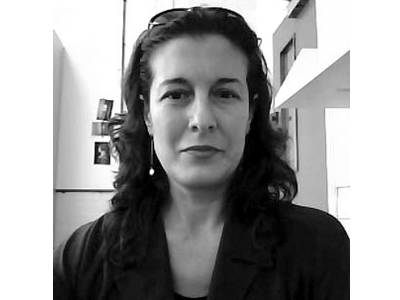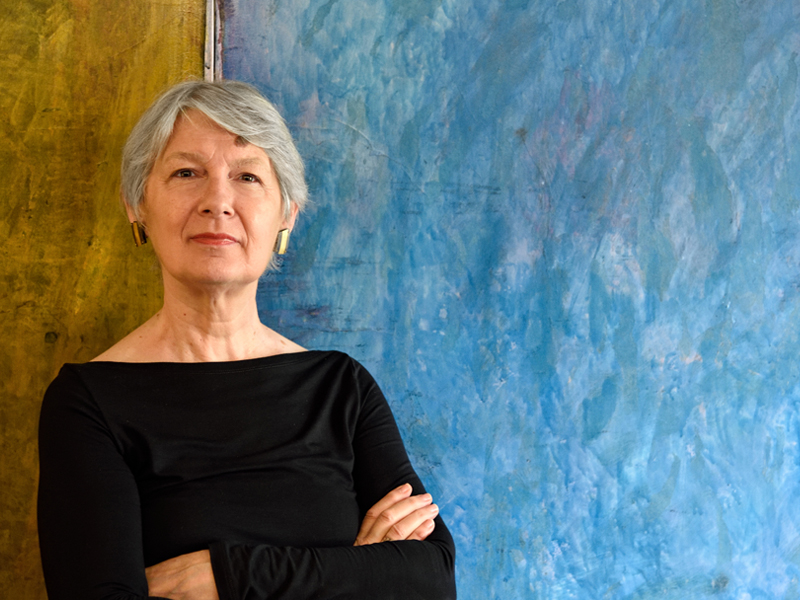
I have been interviewing jewelry makers since 2001, and this has included several exponents of the School of Padua, together with professor Mario Pinton. It is therefore a pleasure to now hear about further developments at the school through the thoughts of one of the key teachers at Padua’s famous Istituto Pietro Selvatico, Maria Rosa Franzin.
Through this conversation, Franzin offers an occasion to understand how her complex role has moved on from safer territories into new explorations of teaching and curating jewelry. It reveals her commitment to embarking on international opportunities to enrich and support the dissemination of contemporary art jewelry. The conversation also illustrates how the jewelry presented for the exhibition Past Present at Alternatives gallery in Rome has been a turning point in her creative career. The show consists of pieces selected by gallerist Rita Marcangelo, herself a pioneer in promoting and instigating an understanding of contemporary art jewelry in Italy since 1995. Finally, the interview signals the rigor of Franzin’s contributions to the world of jewelry over several decades.
Roberta Bernabei: What prompted you to start studying jewelry? Did you already have an interest in jewelry, or did it flourish when you had Mario Pinton as your teacher?
Maria Rosa Franzin: I need to thank my primary school teacher, Prof. Ilde Petek, who opened my mind to the art world, its colors, and the styles of various painters. This is one of the reasons why I decided to study at the Pietro Selvatico Secondary School of Art. Destiny then directed me toward goldsmithing, indicating another possibility. The world of painting therefore transferred into a pictorial dimension based on making. Subsequently, the work done at the school with the maestri of the School of Padua gave me the foundations for further study.
After graduating from the Pietro Selvatico in 1969, you went on to study painting at the Accademia di Belle Arti in Venice. What led you back to jewelry after having studied painting?
Maria Rosa Franzin: I continued to paint until the beginning of the 90s, after which I chose to paint directly on my metal surfaces and forms. In so doing, I was thinking anew about Professor Mario Pinton’s advice to develop one’s own artistic language through the construction of an object or piece of jewelry.
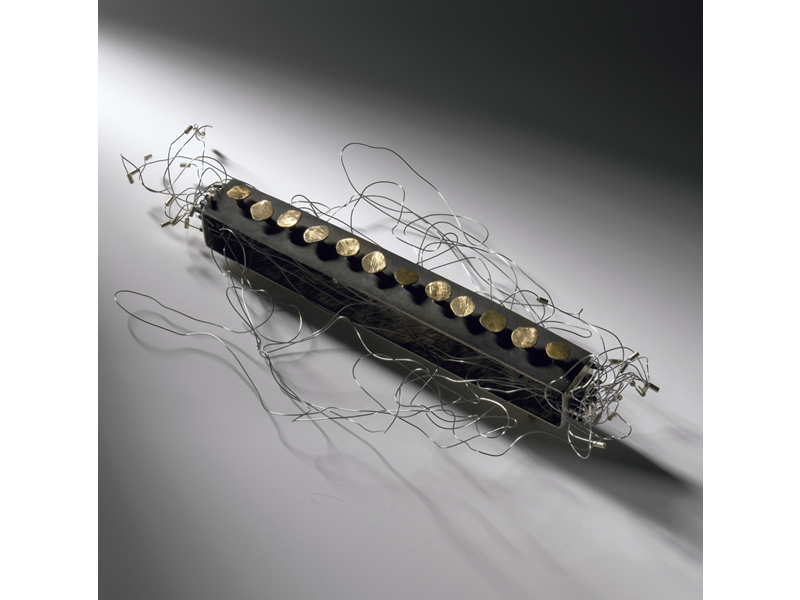
How do you feel you have extended Pinton’s ideas, learning, and teaching principles?
Maria Rosa Franzin: I look for a distinctive sign in my own work by observing the response of metal to heat from fire, the signs that could emerge from an action upon the surface, and materials in which lightness and flexibility could coexist and create a particular tactile effect.
You just had a solo exhibition at Alternatives gallery in Rome. What was the idea or concept behind the body of work presented at the exhibition?
Maria Rosa Franzin: It constitutes turning over a new leaf in my life and research. Many years ago, I saw an interesting exhibition about the life of the Etruscans, their everyday life and their “soul houses.” They viewed these diminutive forms—like tiny houses—as places where the meaning of human beings and their lives were contained.
I started thinking about these envisioned pieces as small containers. Volumes described by a kind of “incorrect” geometry. A sort of construction that is not defined by symmetry, but one that remains free in its form. A kind of place whose external walls, even when heated to a high temperature, still retain their colors and differing shades of light and dark gray. The resulting surfaces almost seem to have been drawn, as if smudged with wax crayon. By contrast, inside the boxes I wanted to animate colors by piling them on top of one another; to intertwine several tones. In some of these pieces I added a wall of resin with a rough surface to divide the space. I regard these little places as a culmination of vital actions, past passions, hidden but not forgotten. I see it as a tormented body that was alive, as what may symbolically remain of a past life and how one may represent to oneself that which was. Many years after that initial encounter, I have understood that it was the right time to give attention to the Case dell’Anima, or Soul Houses.
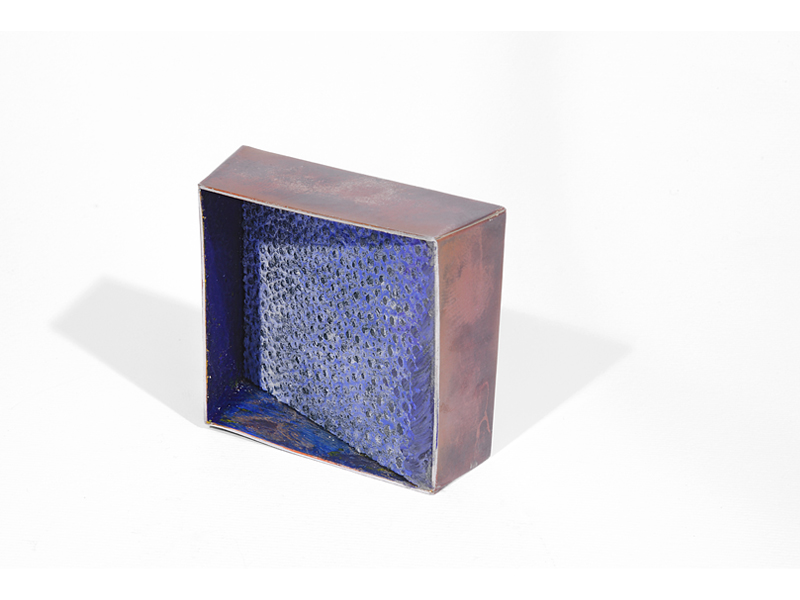
What led you back to bright-colored textures? Is this becoming an important characteristic of your style?
Maria Rosa Franzin: I began to use colored resins in 2010 when I made a brooch for the Gioielli in Fermento competition. On that occasion, I painted metal with earth colors. When painting on a surface, whether small or big, I still feel that the color comes from my hands. In this way, it was a return to my past, when the color and its material structure on paper were united with thought.
You refer to your design method as a sequential plan whereby you create a model based on a series of studies.[1] Could you tell us about the stages of each study? And the criteria to judge the effectiveness of each step of the design development?
Maria Rosa Franzin: The construction phase is of particular importance to the creation of my latest work; it’s achieved through cardboard models, which help me suggest and determine dimensions, measurements, and possible changes. At the same time, I test differing colors on pieces of metal in order to find the different shades that can create a texture in the inner space of my pieces. The chosen colors will then be painted on the pieces of jewelry. Depending on the piece of jewelry, once the construction phase of the form has been completed, I put it aside in order to allow it to “rest” so I can subsequently observe it with fresh eyes and “feel” if it is the right time to start making the object. Then the process of finalizing the work commences by using silver, resin, and acrylic color. This has always been my working method—in which every piece of work has a reflective stage of consideration and then execution.
In the majority of your work, geometry provides a structure within which you position other elements of the composition, such as colored textures on acrylic or metal. How do you achieve the most effective relationship between the geometric structures and the colored surfaces?
Maria Rosa Franzin: The paper model shows me the dimensions and depth. Resin or wood are materials that I use to create a sense of “place” in which there is also something else. Although color certainly occupies space and surfaces, a different material inserted into that space becomes an added gesture, conceived of as a presence.
Mario Pinton, your teacher and the maestro of the School of Padua, whilst reflecting on the role of drawing in the design process, asserts that “geometry is always important even in free expression. In fact, geometry reorders, coordinates and establishes the best sense of design.”[2] Do you feel that geometry imposes rules in your design development?
Maria Rosa Franzin: Geometry helps ensure that the form of a piece of jewelry is not random. I even suggest his words to my students. Everything is supported by geometry. In the course of the object development, you can build in the shape something different by taking some creative liberties, but trying in every case to give the object an internal equilibrium.
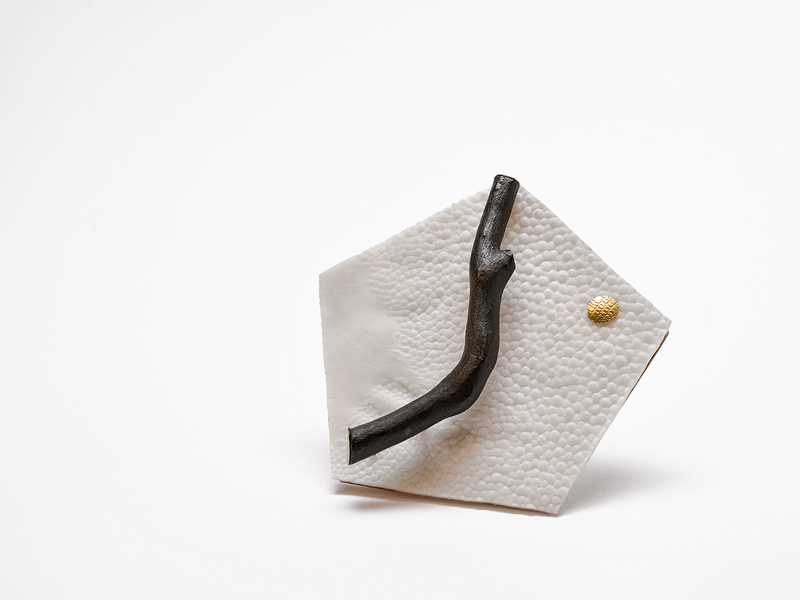
Have you undertaken any notable collaborations?
Maria Rosa Franzin: My collaboration with AGC, the Italian Association for Contemporary Jewellery, which started several years ago: In the first years as a member, then as advisor to the board and finally as president, beginning two years ago. Projects that have been undertaken in the course of time have achieved a good quality in promoting the culture of jewelry. This has fostered several positive relationships with museums and government representatives for cultural activities. In particular, Mirella Cisotto (head of the sector for culture—City of Padua), who is an honorary AGC member, has always demonstrated her esteem for, and been open to collaborating with, our association. The seventh edition of Pensieri Preziosi was dedicated to the AGC association. In 2015, the Italy Japan Dialogui project, in collaboration with the Japanese counterpart association JJDA, supported by the Institute for Italian Culture and the Italian Embassy in Tokyo. After a touring itinerary in Japan, the exhibition has travelled to Italy to several venues, such as Museo della Scienza del Mediterraneo di Livorno, and the Oratorio di San Rocco in Padua where, during the opening, we heard an address by the Japanese ambassador. Next November, the exhibition will be hosted by Museo del Bijoux di Casalmaggiore.
What advice would you give to students who are entering the world of jewelry?
Maria Rosa Franzin: I would say to them that it is important to be aware of those who operate in the jewelry world. Students need to read, visit exhibitions, to discern who might be the jewelers with tangible personal marks, not linked to that of others. I try to make them understand that their personal mark constitutes the power in their own creative languages; and as such requires years of application to hone. In recent years, many new voices have emerged, so it is difficult to stand out from the crowd and to find a means of innovation. Students and anyone entering the world of contemporary jewelry should learn that, in the object, they have to search for its soul. That one should see a message that embodies a sense of self—and not emptiness or improvisation.
What is your proudest jewelry achievement so far?
Maria Rosa Franzin: Yes, over the recent years, some pieces have proved to be special. In 1983 it was the necklace Hartung, my homage to the artist in which the flexibility of steel offered me the opportunity to accurately capture the sensibility of his thin brushstrokes. A few years later, the brooch-object in homage to Francis Bacon. In his work, I felt and still feel the importance of the painted space, as a means to give confines to the distortions and suffering physical forces within. Now, in the Case dell’Anima, I want to deepen the significance of space and of color in the development of my work.

You are an accomplished and complex figure in the contemporary jewelry context. You are an educator at the well-known Istituto Selvatico, president of the Italian Association for Contemporary Jewellery and a very active jewelry maker at the international level. How do you manage these roles?
Maria Rosa Franzin: I employ my father’s word: patiently. In effect there are several roles, but living them simultaneously they somehow accommodate one another. These roles are part of my life. Going to the studio and working, making new pieces, searching for optimal solutions. Living in my environment has always been a place where time is not defined by working days or holidays. It is a means to find myself every day.
Going to the Pietro Selvatico School to teach, as I have for the last 40 years, means reinvigorating my words about design methods for the new young students that I meet in the classroom. As well as seeing them again after they have completed their studies and maintaining a friendly relationship.
I had a beautiful experience at the Beijing Institute of Fashion Technology. I spent three weeks in Peking with a group of 40 motivated students who wanted to learn design methods and technical skills as we teach them at the Pietro Selvatico School. I have maintained contact with them, and to this day they send me images of their pieces of work and ask for advice on form and materials.
My role within the AGC consists in searching, with board advisors and our many members, for the best solutions to support quality and innovation within the association. Beyond the aforementioned Dialoghi project, since 2010 I have been the co-curator of the Cominelli Foundation Prize for Contemporary Jewellery with Rossella Tornquist (AGC member) and Rosanna Padrini.
The curation of exhibitions and competitions is a very intense and complex job, but the reward is the opportunity to know—and be known by—a multitude of makers from every part of the world. Various national and international educational bodies invited to the Cominelli Foundation have turned out to be a great source of information for the use of alternative materials and techniques, as well as for alternative teaching programs.
I would like to cite the permanent Cominelli collection on show at the foundation. Since 2011, the curator has been Rita Marcangelo, a founder and member of the AGC. This permanent collection is composed of 80 pieces by international makers, and is the first and largest collection of contemporary art jewelry in Italy. The AGC and I are very proud of it and the recognition it has received internationally. Finally, I would like to say that I am gratified by my work and for this opportunity to be interviewed. I am glad that two AGC members have been able to formulate, through questions and answers, a text which will be read on AJF. Thank you.
Finally, what are your jewelry plans for the future?
Maria Rosa Franzin: I like to have a project on the horizon. The next one this year is an exhibition with Gigi Mariani in Rome at Alternatives gallery, and in 2017 a solo exhibition at OHMYBLUE in Venice. There will be other projects for the AGC, and other competitions with my students in relation to educational institutions.
… and then … we will see.
Work in the exhibition ranges in price from $450 to $1,500.
Original text translated by Roberta Bernabei.
INDEX IMAGE: Maria Rosa Franzin, Casa Anima 4, 2016, brooch, silver, acrylic paint, boxwood, 60 x 20 x 30 mm, photo: Silvano Longo

IN ITALIANO
Ho intervistato artisti del gioiello d’arte sin dal 2001, inclusi alcuni esponenti della Scuola di Padova tra i quali il maestro Mario Pinton. E’ con gran piacere che mi accingo a divulgare gli sviluppi della Scuola di Padova attraverso i pensieri di uno degli insegnanti chiave del famoso Istituto Pietro Selvatico.
Attraverso questa conversazione, Maria Rosa Franzin, ci offre l’occasione di capire come il suo ruolo si sia mosso da territori familiari a nuove esplorazioni nell’insegnamento e nel curare mostre sul gioiello.
Ci rivela l’impegno sostenuto nell’ impegnarsi verso nuove opportunità per arricchire e sostenere, a livello internazionale, la diffusione del gioiello contemporaneo d’arte. La conversazione prosegue illustrando come la creazione dei lavori per la mostra ‘Past Present’ presso la galleria Alternatives di Roma, rappresenti una svolta nella sua carriera artistica.
Quest’ultima produzione è stata selezionata dalla direttrice della galleria Rita Marcangelo; lei stessa è una figura importante per aver promosso la comprensione del gioiello contemporaneo d’arte in Italia sin dal 1995. Concludendo, l’intervista segnala il rigore delle contribuzioni di Maria Rosa Franzin, nel mondo del gioiello da diverse decadi.
Roberta Bernabei: Cosa ti ha fatto decidere di studiare nel campo del gioiello? Avevi già un interesse nel gioiello o è sbocciato quando hai avuto Mario Pinton come tuo insegnante?
Maria Rosa Franzin: Devo ringraziare una mia insegnante di scuola media, la Prof.ssa Ilde Petek, la quale mi ha aperto la mente sul mondo dell’arte, del colore e dei caratteri dei pittori, ho voluto anche per questo continuare gli studi all’Istituto d’Arte ‘Pietro Selvatico’. Il destino ha poi virato verso l’oreficeria indicandomi un’altra possibilità. Il mondo della pittura si è così avviato in un’altra dimensione pittorica ed operativa. Successivamente il lavoro scolastico, con i maestri della Scuola di Padova, mi ha dato le indicazioni per gli anni successivi.
Terminati gli studi nel 1969 presso la scuola superiore Pietro Selvatico di Padova, decidesti di frequentare l’Accademia di Belle Arti sezione pittura a Venezia. Cosa ti ha poi riportato al gioiello dopo aver studiato pittura?
Maria Rosa Franzin: Ho continuato infatti la pittura fino ai primi anni 90, decidendo poi di avvicinare il mio modo di dipingere alla superfice del metallo e alle forme. Ho ripensato alle indicazioni del prof. Pinton nelle quali egli suggeriva di sviluppare il proprio segno personale in ciò che è la costruzione di un oggetto/gioiello.
Come pensi di aver ampliato i metodi di apprendimento, insegnamento e i principi delle idee di Mario Pinton?
Maria Rosa Franzin: Cercando di determinare un tratto riconoscibile, osservando la reazione del metallo al calore del fuoco, al segno che poteva sorgere con un intervento nella superficie, al materiale particolare in cui leggerezza e flessibilità potevano convivere e rendere così un particolare effetto al tatto.
Hai appena avuto una mostra presso Alternatives a Roma. Qual’ era l’idea o il concetto della collezione presentata alla mostra?
Maria Rosa Franzin: Questo è un lavoro che volta pagina, di vita e di ricerca. Molti anni fa avevo visto una interessante mostra sulla vita ed il quotidiano nel popolo degli Etruschi e nelle loro case dell’anima. Le forme di piccole dimensioni, proprio come piccole case, erano considerate luoghi in cui veniva raccolto il significato dell’uomo e della sua vita.
Ho pensato a questi lavori come piccoli contenitori, a volumi costruiti con una geometria un po’ “sbagliata” cioè ad una sorta di costruzione che non racchiude in sé la simmetria, ma che si rappresenta libera nella sua forma.
Una sorta di luogo, le cui pareti esterne riscaldate fortemente con il fuoco mantengono poi il colore prodotto dalla sua forza e le tonalità ottenute in grigi chiari e scuri, paiono superfici come se fossero state disegnate sfumando a mano con il pastello.
Diversamente, all’interno, ho voluto animare i colori sovrapponendoli uno sull’altro, ho intrecciato i diversi toni, ed ho inserito in alcuni di questi oggetti una parete di resina ruvida al tatto, così da poter dividere lo spazio. Guardo a questi piccoli luoghi come ad un sunto di azioni vitali, passioni passate, nascoste, non dimenticate, il tormento di un corpo che era in vita. Ciò che può rimanere simbolicamente di una vita passata e ciò che si può rappresentare per ciò che è stato.
A distanza di anni ho capito che questo può essere il momento per porre attenzione alle Case dell’Anima.
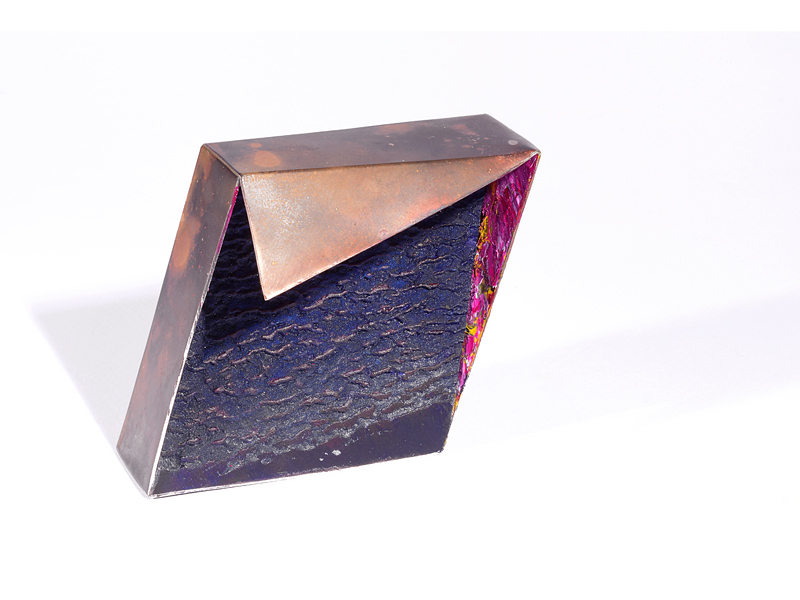
Cosa ti ha condotto di nuovo ad usare dei colori molto intensi e la testura? Pensi che questa stia diventando una caratteristica importante del tuo stile?
Maria Rosa Franzin: Avevo iniziato ad usare il colore con le resine nel 2010, realizzando successivamente anche una spilla, costruita sul tema della mostra di Gioielli in Fermento, in cui ho dipinto sul metallo i colori della terra. Dipingere su una superficie, che sia questa grande o piccola mi fa ancora sentire che il colore esce dalle mani. In queste “Case” vi è stato un ritorno al passato, quando il colore e la sua struttura materica nella carta si fondevano con il pensiero.
Ti riferisci al tuo metodo progettuale come un piano per creare un modello basato su una serie di studi. Potresti illustrarci i vari passaggi? Quali sono i criteri che utilizzi per giudicare l’efficacia di ogni stadio della progettazione?
Maria Rosa Franzin: Nell’ideazione di questi miei ultimi lavori considero molto importante il percorso costruttivo in cui i diversi modelli realizzati in cartoncino mi sono d’aiuto per suggerire e per evidenziare dimensioni, misure ed eventuali cambiamenti. Nello stesso tempo eseguo le prove di colore su pezzi di metallo per trovare le diverse tonalità che possano anche rendere una superficie materica nello spazio interno. I colori scelti saranno dipinti poi nel gioiello.
Terminata la fase costruttiva della forma, lascio il modello per un breve o lungo periodo, (dipende dal tipo di oggetto) a “riposare” per guardarlo e per “sentire” se è giunto il tempo per cominciare il lavoro. Inizia poi il procedimento per la sua realizzazione, utilizzando il metallo di argento, la resina e il colore acrilico. Questo è da sempre il mio metodo di lavoro, in cui ogni pezzo ha una sua fase di pensiero e di esecuzione.
Nella maggior parte dei tuoi lavori la geometria procura una struttura all’interno della quale posizioni altri elementi per la composizione, per esempio la testura colorata su acrilico o metallo. Come raggiungi una relazione efficace (ottimale) tra la struttura geometrica e le superfici colorate?
Maria Rosa Franzin: Il modello in carta, mi indica la dimensione e la profondità. La resina o il legno, sono forme che utilizzo per determinare un effetto di “luogo” in cui c’è anche qualche altra cosa. Certo anche il colore occupa spazio e superficie, ma un materiale diverso inserito in quello spazio diventa un gesto in più, inteso come presenza.

Mario Pinton, tuo insegnante Maestro della Scuola di Padova, mentre riflette sul ruolo del disegno nella progettazione, dichiara: “la geometria è sempre importante anche nell’espressione libera. In fatti, la geometria riordina, coordina e instaura un miglior senso del disegno” (Bernabei, 2011, p 164). Pensi che la geometria imponga delle regole nello sviluppo della progettazione?
Maria Rosa Franzin: La geometria aiuta a non rendere casuale la forma di un oggetto. Anche ai miei allievi suggerisco le sue parole. Tutto è sorretto dalla geometria, ma in corso d’opera puoi costruire nella forma qualcosa di diverso prendendoti delle libertà espressive ma cercando in ogni caso che nell’oggetto vi sia misura ed equilibrio.
Potresti parlarci di alcune collaborazioni memorabili?
Maria Rosa Franzin: Il mio impegno con l’Associazione AGC lo considero una collaborazione memorabile che si svolge già da parecchi anni, nei primi anni come socio, poi come consigliere e quest’anno con il secondo mandato per la presidenza.
I progetti che si sono realizzati nel corso del tempo hanno raggiunto una buona qualità nella promozione della cultura del gioiello stabilendo così positivi rapporti con diverse istituzioni museali ed Assessorati alla Cultura.
Mirella Cisotto (Capo Settore Cultura del Comune di Padova) che è nostro Socio onorario, ha sempre dimostrato grande stima per la nostra Associazione, promuovendo e partecipando ai nostri progetti ed eventi, rendendosi sempre disponibile con la sua collaborazione. La settima edizione di Pensieri Preziosi era stata dedicata ad AGC. Nel 2015 per il progetto Dialoghi Italia Giappone, in collaborazione con l’Associazione JJDA, con i consensi dell’Istituto di Cultura Italiano a Tokyo e dell’Ambasciata italiana, dopo l’itinerario di mostre in Giappone abbiamo esposto nel 2016 al Museo della Scienza del Mediterraneo di Livorno e all’Oratorio di San Rocco a Padova dove ci è stato inoltrato durante l’inaugurazione il messaggio dell’Ambasciatore Giapponese. L’itinerario proseguirà il prossimo novembre al Museo del Bijoux di Casalmaggiore.
Che consigli daresti agli studenti che si accingono a studiare nel mondo del gioiello?
Maria Rosa Franzin: Dico loro che è importante essere informati su ciò che si muove nell’ambito del gioiello, che devono leggere, visitare le mostre, vedere quali possono essere le figure che determinano un segno personale tangibile, che non si leghi ad altri o che attinga dal lavoro altrui.
Cerco di far capire che il segno personale è la forza del loro costruire, e che per questo sono necessari anni di applicazione. In questi ultimi tempi si sono sviluppate tantissime voci, è difficile farsi largo, e trovare il modo per determinare un segno di innovazione.
Gli studenti o chi si avvicina al mondo del gioiello contemporaneo e di ricerca, soprattutto devono imparare che dentro all’oggetto si deve intuire la sua anima, si deve leggere un messaggio che raccolga il senso del sé e non il vuoto o l’improvvisazione.
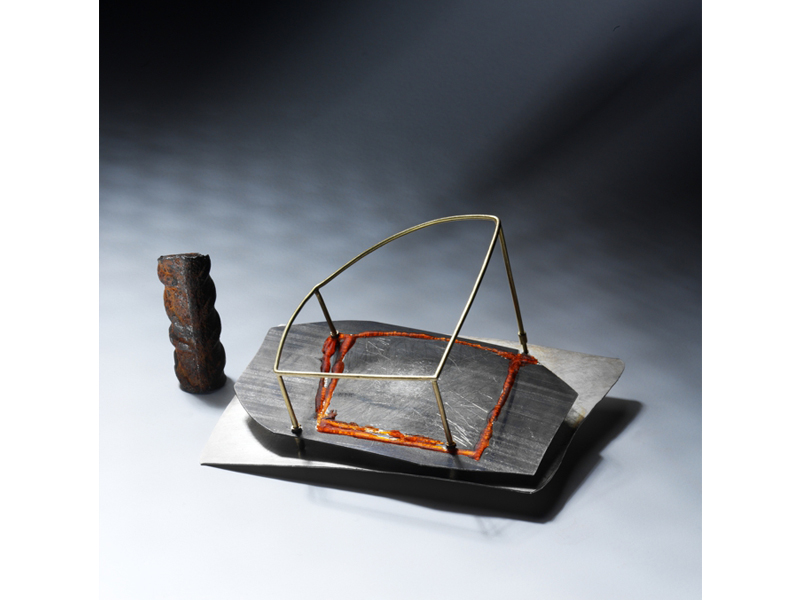
Di quale progetto ti senti particolarmente orgogliosa?
Maria Rosa Franzin: Sì vi son stati alcuni pezzi che si sono evidenziati in questi anni. Nel 1983 è stata la collana Hartung, il mio omaggio al pittore, in cui il materiale di acciaio flessibile mi aveva offerto il giusto senso delle sue pennellate sottili. Alcuni anni più tardi l’oggetto spilla, omaggio a Francis Bacon. Avevo sentito e sento ancora importante nelle opere di questo autore lo spazio disegnato che delimita la distorta e sofferente forza fisica al suo interno.
Ora nella Casa dell’Anima voglio approfondire questo significato di spazio e di colore per svilupparlo nella mia evoluzione.
Nel gioiello contemporaneo sei una figura esperta e complessa che ricopre diversi ruoli come: educatrice presso il conosciuto Istituto Selvatico, presidente dell’AGC e artista orafa conosciuta e attiva a livello internazionale. Come concili questi ruoli?
Maria Rosa Franzin: Se posso dire, uso un termine di mio padre: pazientemente.
Certo in effetti sono tanti ruoli, ma vivendoli ognuno nel proprio spazio si accomodano tra di loro. Queste funzioni sono parte della vita. Andare in studio e lavorare, costruire nuovi pezzi, cercare le risoluzioni ottimali, vivere nel mio territorio è da sempre il luogo dove non vi è tempo scandito da giorni festivi o vacanze. E’ ritrovare ogni giorno me stessa.
Entrare in classe a far lezione alla Scuola Selvatico, ormai da 40 anni, per me vuol dire rinnovare le parole sulla progettazione per i nuovi giovani che incontro in aula, rivedendoli poi anche quando hanno terminato il corso degli studi, e mantenere un contatto amichevole.
Ho fatto una bellissima esperienza all’estero una Class al Beijing Institute Fashion Technology. Ho passato tre settimane a Pechino con quaranta studenti desiderosi di apprendere le tecniche di progettazione e di laboratorio sul modello della Scuola Selvatico. Anche con loro ho mantenuto i contatti e mi inviano ancora adesso le immagini dei loro lavori per avere le mie considerazioni sulle forme ed i materiali che utilizzano.
Pensare ad AGC è per me trovare con i membri del direttivo ed i soci, le migliori possibilità per rendere la nostra un’Associazione innovativa e di qualità. Oltre al progetto Dialoghi già citato, sono co-curatrice dal 2010 con la socia AGC Rossella Tornquist e con Rosanna Padrini referente della Fondazione, del Premio Fondazione Cominelli per il Gioiello Contemporaneo.
E’ un lavoro molto intenso e complesso curare mostre e concorsi ma il riscontro è l’opportunità di conoscere ed essere conosciuti da moltissimi autori di ogni parte del mondo. Le istituzioni scolastiche nazionali ed internazionali che ho invitato nella sede della Fondazione son divenute fonte di proposte per le tecniche e per l’uso di materiali diversi unite alla conoscenza di diverse programmazioni nell’insegnamento.
Vorrei anche citare la Collezione Permanente ora in esposizione alla Fondazione Cominelli di cui è curatrice dal 2011 è Rita Marcangelo, socia fondatrice di AGC. La collezione comprende 80 autori internazionali, è stata ed è la prima ed unica grande raccolta in Italia per ciò che riguarda il Gioiello Contemporaneo e di ricerca. Di questo l’Associazione ed io ne siamo molto orgogliose anche per il consenso ottenuto a livello internazionale.
Ed infine mi piace dirti che mi sento gratificata per il mio lavoro anche da questa opportunità, da questa tua intervista. Son felice che due socie AGC si ritrovino a formulare tra domande e risposte un testo che sarà letto in AJF. Vi ringrazio.
Quali sono i tuoi piani futuri nel contesto del gioiello?
Maria Rosa Franzin: Mi piace avere sempre un progetto all’orizzonte. Quest’anno ci sarà la mostra con Gigi Mariani a Roma alla Galleria Alternatives e nel 2017 la mostra personale a Venezia alla Galleria OHMYBLUE.
Vi saranno altri progetti per AGC ed altri concorsi in ambito scolastico che si stanno sviluppando con il lavoro dei miei allievi.
… e poi per il resto…ci pensiamo.

Bibliografia
R. Bernabei, (2011) Contemporary Jewellers: Interviews with European Artists, Bloomsbury, Oxford.
